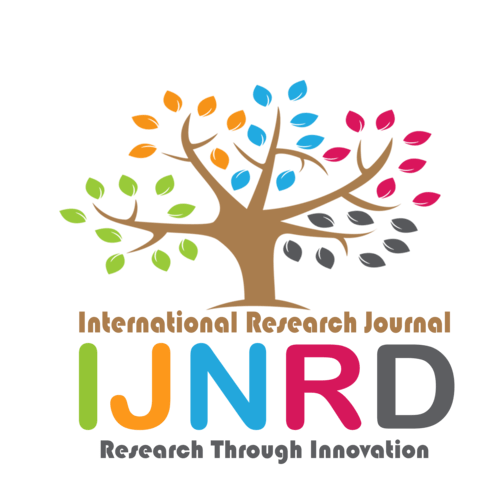|
|||||||||||||||

|
INTERNATIONAL JOURNAL OF NOVEL RESEARCH AND DEVELOPMENT International Peer Reviewed & Refereed Journals, Open Access Journal ISSN Approved Journal No: 2456-4184 | Impact factor: 8.76 | ESTD Year: 2016 Scholarly open access journals, Peer-reviewed, and Refereed Journals, Impact factor 8.76 (Calculate by google scholar and Semantic Scholar | AI-Powered Research Tool) , Multidisciplinary, Monthly, Indexing in all major database & Metadata, Citation Generator, Digital Object Identifier(DOI) |
||||||||||||||
Issue: May 2024
Volume 9 | Issue 5
Review Result and Publication of Paper within : 2-3 days
Click Here For more DetailsFor Authors
Forms / Download
Published Issue Details
Editorial Board
Other IMP Links
Facts & Figure
Impact Factor : 8.76
Issue per Year : 12
Volume Published : 9
Issue Published : 96
Article Submitted :
Article Published :
Total Authors :
Total Reviewer :
Total Countries :
Indexing Partner
Join RMS/Earn 300
Licence
This work is licensed under a Creative Commons Attribution-NonCommercial 4.0 International License







|
Published Paper Details
|
|
| Paper Title: | The Role Oil in Shaping Foreign Policy in West Asia: A Case Study Of Saudi Arabia and Iran |
| Authors Name: | Atishi Rawat |
| Download E-Certificate: | Download |
| Author Reg. ID: |
IJNRD_216750
|
| Published Paper Id: | IJNRD2403642 |
| Published In: | Volume 9 Issue 3, March-2024 |
| DOI: | |
| Abstract: | THE ROLE OF OIL IN SHAPING FOREIGN POLICY IN WEST ASIA: A CASE STUDY OF SAUDI ARABIA AND IRAN INTRODUCTION Oil is integral in terms of strategic significance and the geopolitical landscape for West Asia. This acts like a linchpin to influence their foreign policies from major nations within this region. This study mainly concentrates on two main players Saudi Arabia and Iran, from knowing to a large extent the intricate details of their oil wealth helping in determining how their diplomatic strategies unfold. Since both countries have significant impact on oil markets around the world, their foreign policies are not simply responses to localized issues but also manipulated by the upward and downward movement in the energy sector. The link between oil and West Asian foreign policy started in the first half of the 20 th century when petroleum was found beneath deserts of this part of the world. 2 decades later, the energy trade went through a massive makeover and West Asian countries came up as major players in an industry that would soon become almost synonymous with geopolitical influence. A look at Saudi Arabia and Iran can be taken as a case study of how oil has been related to the trappings of their foreign policy issues. This relationship has profound economic facets. The economies of both Saudi Arabia and Iran are strongly dependent on oil revenues, with the performance in the international oil market significantly influencing their respective economic performances. The economic stakes are also very high and the policy decisions, foreign affairs of these nations are always anchored on this search for stable and ever-increasing economy. If one is to make any sense out of motivations that inform the kind of choices these nations would take in regard to their foreign policy decisions, it then becomes essential for one to understand the complex dance between oil prices production levels and economic welfare of such nations. Saudi Arabia and Iran clearly demonstrate how oil dependence has geopolitical implications. Saudi Arabia is the world’s leading exporter of oil and plays a large role in international alliances and deals. Part of the country’s foreign policy decisions can be attributed to it being an energy giant. Unlike Nigeria at that time, Iran today has a massive reservoir of oil at its disposal, which it uses in two capacities- as a foreign policy tool on one hand and to bolster resilience under pressure from the outside world, on the other. West Asia is a geopolitical field full of countless nuances where oil means the currency of diplomacy. However, oil reliance presents both challenges and opportunities for these countries. They are subjected to economic uncertainties that emanate from the volatility of oil prices and cyclicality of operations within this sector. Innovative foreign policies that can reliably guide through periods of plenty as well as times of want are required. In addition, the shift towards renewable energy and increased endorsement of environmental sustainability worldwide pose challenges to the long-term viability of economies that rely on oil. The contours of Saudi and Iranian foreign policies reflect a delicate task of balancing economic imperatives with the imperative to adapt to changing global energy landscape. The case study approach is utilized by this research to look into the oil-centred foreign policy strategies employed by Saudi Arabia and Iran. It discusses past events, policy decisions and political exchanges to unveil missile as an element that played the role of an intermediary in re-shaping West Asian geopolitics. By taking into consideration such specific challenges, opportunities and delicate features of the policy in question this approach helps to get ensnarement in the nature of these two countries in their international affairs based on tremendous oil products. In West Asia, the interplay between oil and foreign policy is a riveting narrative of economic imperatives, geopolitical manoeuvring, and regional power. At the core of this complex network are two major players: Saudi Arabia and Iran, whose foreign policies are inextricably linked to the massive oil deposits that define their respective national identities. The history of oil in West Asia is defined by transformational historical events that have global ramifications. The discovery of large hydrocarbon deposits catapulted the area to prominence, making it a strategic priority for major nations. Saudi Arabia and Iran emerged as key players whose fates were linked to the flow of oil and the shift in global energy market patterns. Oil-producing countries emphasised their joint strength with the formation of the Organisation of Petroleum Exporting Countries (OPEC) in 1960. This was a turning point in the confluence of economic and foreign policy concerns. Saudi Arabia, as a founding member of OPEC, began presenting itself as a global energy giant, leveraging its oil wealth to propel foreign policy forward. Oil has a significant role in the economies of both Saudi Arabia and Iran. Since petroleum has become a big element of their GDP and government income, many countries have built economies centred on oil production and export. Their economic fate is inextricably related to the massive changes in global oil prices. Foreign policy decisions are no longer only a matter of international relations; they have also evolved into a more pragmatic reaction to economic imperatives. As the world's top oil exporter, Saudi Arabia relies on oil money to maintain economic stability. The country's Vision 2030 plan, which aims to diversify the economy, recognises the need to lessen reliance on oil. However, the move to a post-oil future would require diplomatic skill to achieve a seamless transition without jeopardising national interests. Meanwhile, Iran has faced economic challenges in addition to international sanctions. As a result, oil becomes a tool for economic recovery and resilience. Iran and the Joint Comprehensive Plan of Action (JCPOA) Background The JCPOA, while focused on Iran's nuclear programme and easing of some restrictions, had an influence that extended beyond these concerns; it paved the way for Iran to rejoin the global oil market. Beyond the economic world, the position of oil echoes in geopolitical power corridors. Saudi Arabia, being one of the wealthiest in oil reserves, has utilised its resources to forge alliances and dominate the world. The kingdom's strategic relationship with the United States is mostly based on common economic interests in the oil sector. Using oil as a bargaining tool in geopolitics is a delicate diplomatic dance. This is also the narrative of Iran, a country with enormous oil reserves of its own. So far, implementing sanctions aimed at reducing Iran's oil earnings has pushed the country to traverse complex diplomatic terrain in order to avoid economic hardship. The research explores the foreign policy initiatives driven by oil in Saudi Arabia and Iran. Delving into historical events, policy decisions, and political interactions. By examining specific challenges, opportunities, and nuanced aspects of the policy at hand, the approach provides insights into the distinctive features of these two countries in their international interactions influenced by abundant oil reserves. |
| Keywords: | |
| Cite Article: | "The Role Oil in Shaping Foreign Policy in West Asia: A Case Study Of Saudi Arabia and Iran ", International Journal of Novel Research and Development (www.ijnrd.org), ISSN:2456-4184, Vol.9, Issue 3, page no.g353-g370, March-2024, Available :http://www.ijnrd.org/papers/IJNRD2403642.pdf |
| Downloads: | 00036 |
| ISSN: |
2456-4184 | IMPACT FACTOR: 8.76 Calculated By Google Scholar| ESTD YEAR: 2016 An International Scholarly Open Access Journal, Peer-Reviewed, Refereed Journal Impact Factor 8.76 Calculate by Google Scholar and Semantic Scholar | AI-Powered Research Tool, Multidisciplinary, Monthly, Multilanguage Journal Indexing in All Major Database & Metadata, Citation Generator |
| Publication Details: |
Published Paper ID:IJNRD2403642 Registration ID: 216750 Published In: Volume 9 Issue 3, March-2024 DOI (Digital Object Identifier): Page No: g353-g370 Country: GHAZIABAD, UTTAR PRADESH, India Research Area: Other Publisher : IJ Publication Published Paper URL : https://www.ijnrd.org/viewpaperforall?paper=IJNRD2403642 Published Paper PDF: https://www.ijnrd.org/papers/IJNRD2403642 |
| Share Article: | |
|
Click Here to Download This Article |
|
| Article Preview | |
|
|
|
Major Indexing from www.ijnrd.org
| Semantic Scholar | Microsaoft Academic | ORCID | Zenodo |
| Google Scholar | ResearcherID Thomson Reuters | Mendeley : reference manager | Academia.edu |
| arXiv.org : cornell university library | Research Gate | CiteSeerX | PUBLON |
| DRJI | SSRN | Scribd | DocStoc |
ISSN Details
 |
 |
ISSN: 2456-4184
Impact Factor: 8.76 and ISSN APPROVED
Journal Starting Year (ESTD) : 2016
DOI (A digital object identifier)
Conference
Open Access License Policy
Important Details
Social Media
| Copyright © 2024 - All Rights Reserved - IJNRD |












Facebook Twitter Instagram LinkedIn